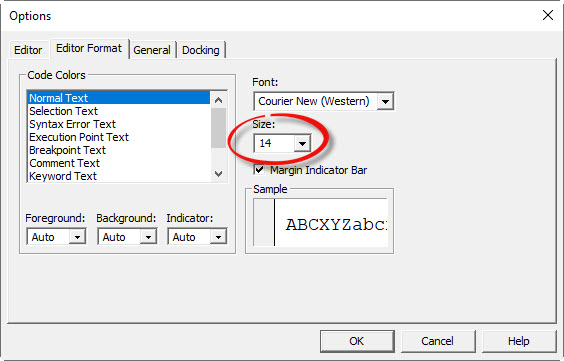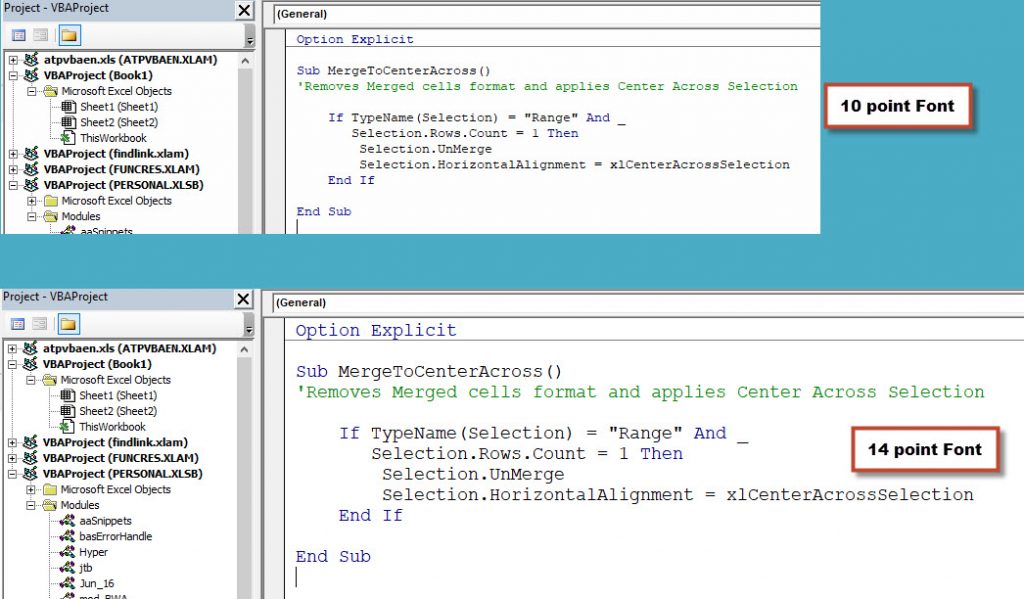I recently read an Excel VBA book that recommended using numbers instead of VBA constants for message boxes. Please don’t do that. Here’s why.
Tag Archives: Macros
Excel VBA and the TRUNC Function
Excel has a TRUNC function that truncates numbers. For example =TRUNC(15.75) returns 15. It doesn’t round it just removes the fraction leaving the whole number. Excel VBA does not have the TRUNC function. It does have the Fix function that works the same.
Excel VBA to Get to the Top Left of the Screen
Sometimes when you are using Excel VBA you need the screen to always display at the top, left of the sheet. Here is how you do it.
Quotation Marks in Excel VBA
Sometimes when you are building a text string in VBA you may need to insert quotations marks. That poses a problem because quotation marks are used to surround the text you want to join and using them within the text is problematic. There is a solution.
Excel VBA Sort Sheet Tabs by Colour
Get your sheet tabs organised
Using colours on your sheets can help you navigate and organise your file. If you want to sort your sheets by colour you can use a macro to speed up the process.
Excel File is Open VBA Function
Useful function
When working with files in VBA code, you may need to know if a file is already open. A function can return TRUE if a file is currently open and FALSE if it isn’t.
Sheet Exists Function for Excel VBA
A function macro to help another macro
Often when you are working with Excel VBA you need to confirm if a sheet exists based on the tab name. This Function can be used to do that. It works with the active file (workbook).
Clearing Unlocked Cells in Excel
A macro makes it easy
People always ask, how to do you lock Excel? In fact you have to unlock Excel and then protect the sheet. The default setting for all cells is locked, so you need to unlock input cells.
Another Useful Print Macro
And it is recorded
Not all recorded macros are re-usable. This print selection one is.
Excel Macros and Merged Cells
Merged cells are a problem
I don’t like merged cells. Here is one more reason.
Save and Close extra
Handling read only and new workbooks
In my previous post I created a macro from scratch that saved and closed the current file. The macro required that the file had been saved before and wasn’t read only. This post handles those two situations so you can run the macro on any file and it will only work when required.
Save and Close in Excel
Let's create a macro
I started using Excel in the late 80’s on a Mac. It had a Save and Close button. When I discovered VBA in Excel on the PC, the very first macro I ever made was save and close.
I thought this would be a good example to take you through creating a macro from scratch and sharing a technique to make it easy to use.
Use an Outlook template for an email
Why is it so hard to do?
Macros are designed to reduce keystrokes and mouse clicks. Here is a perfect example. It takes seven separate mouse clicks to use an Outlook email template as a new email. Here is a macro that does it in one.
Excel VBA to confirm a range is selected
You need to type TypeName
One of the most powerful statements in VBA is Selection. This holds whatever the user has selected just before they ran the macro. Normally it is a range, but what if it isn’t?
Excel VBA to select the first cell in a range
Top left cell
If you need to refer to the first cell (top, left cell) in a range there is an easy way to do it.
VBA tip – please don’t leave your Next blank
Include the variable
In a For Next loop you don’t have to include the variable in the Next statement. But ….
Activating a Sheet When an Excel File is Opened
Its a macro
There are times when you would like to have the same sheet visible each time a file is opened. You can achieve that with a Workbook Event macro.
Excel Macro to Insert a Formula
When I am creating a file for my training or for my blog or other articles that I write I regularly use the FORMULATEXT function to display the formula in a cell on the right of the actual formula. To save time I created a macro to do the work for me.
Extract Email from Copied Outlook Address
Macro to the rescue
I frequently copy an email address from Outlook to Excel and most times it looks like John Smith<jsmith@email.com>. To be used as an email I need to extract from between < and >. To do that in a single cell is tedious, so I wrote a macro to do it for me.
Increase Font Size in VBA Window
Easy change
Yes, you can make the text in the VBA window easier to read.
It is also great for training.
(This tip may not work on 4K monitors.)
To open the VBA Window press Alt + F11.
Click the Tools menu and then Options – see image below.
Click the Editor Format tab and change the Size drop down to 14, or whatever you want – see image below.
Click OK and the font size will now be increased in the code window.
See below for a comparison between 10 and 14 point.
Much easier to read!
Free Webinar Recording – Recorded Macros Tips Tricks and Traps
Getting started with recorded macros
It is easy to create a recorded macro. It is not so easy to create a flexible and re-usable recorded macro. Click the materials Button below to download the pdf manual and example file.
Learn the techniques that can allow you to record effective macros that can handle different ranges and changes to sheet names.
Macros can speed up your work and reduce the time taken for tedious tasks, as well as adding functionality to Excel.
This is the first in a series of webinars dedicated to macros. Future paid sessions this month (August 2019) will expand on the techniques taught in this session. Click here to register.
CPD note – if you are claiming CPD for watching this recording you need to keep your own records. People who attend the live sessions receive an annual listing of attendances.
Excel ISDATE Function
A few solutions
Unfortunately Excel doesn’t have an ISDATE function. Excel’s macro language, VBA does, but there is no spreadsheet function that let’s you know if a cell contains a date. Well there is a partial workaround and you can also use VBA.
Autofit Rows with a Maximum Row Height
Follow up post
In March I wrote a post on using a macro to apply column Autofit on a sheet but with a maximum column width. This is a follow up post as someone requested the same functionality for row height.
Autofit columns with a limit
A macro to the rescue
The column Autofit on the whole sheet is a great Excel feature. But if you have a few columns that have lots of text it can make using it problematic as you need to manually adjust those wide columns. Here’s a macro to make it easier.
Navigation in the VBA Window
An Excel shortcut
I recently found a useful keyboard shortcut for the VBA code window. I tried an Excel shortcut that helped in the VBA window.
Free Excel Webinar Recording – Excel Yourself 2018
Feedback score 89%
In December 2018 I reviewed four of my articles from the INTHEBLACK magazine from 2018. Download the materials using the button below and watch the video.
CPD note – if you are claiming CPD for watching this recording you need to keep your own records. People who attend the live sessions receive an annual listing of attendances.
Includes extra content not included in the magazine.
This year’s smorgasbord webinar includes
- how to handle validations
- dynamically highlighting the current row in a table (uses a macro)
- centralising logic – how and why to do it – alternatives to the IF function
- creating a slope chart (includes a macro to speed up the process)
As always there will be a few more tips and tricks shared in the session.
First and Last Cell Address in a Range
Following on from my last two VBA posts here is how you can identify the cell addresses of the first and last cells in a range.
VBA to Find the Row and Column Number Limits of a Range
First and last row and column numbers
In my last blog post I found the last used row and column numbers on the active sheet. This post lets us find the row and column extremities of a specific range.
Excel VBA to Find the Last Used Row or Column
UsedRange used wisely
When writing VBA code it is common to need to know the last used row and/or the last used column. These values provide the edges of the sheet contents.
Range Names and Macros
Range names rule
When you record a macro that refers to a particular cell or range on a particular sheet in Excel the range reference is hard coded into VBA (macro) code. Unfortunately this means if rows or columns are inserted or deleted in the reference range the code is not updated. There is an easy way to get around this.


